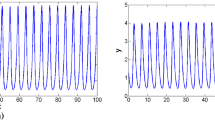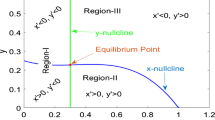Abstract
Human-induced extinction and rapid ecological changes require the development of techniques that can help avoid extinction of endangered species. The most used strategy to avoid extinction is reintroduction of the endangered species, but only 31% of these attempts are successful and they require up to 15 years for their results to be evaluated. In this research, we propose a novel strategy that improves the chances of survival of endangered predators, like lynx, by controlling only the availability of prey. To simulate the prey-predator relationship we used a Lotka-Volterra model to analyze the effects of varying prey availability on the size of the predator population. We calculate the number of prey necessary to support the predator population using a high-order sliding mode control (HOSMC) that maintains the predator population at the desired level. In the wild, nature introduces significant and complex uncertainties that affect species’ survival. This complexity suggests that HOSMC is a good choice of controller because it is robust to variability and does not require prior knowledge of system parameters. These parameters can also be time varying. The output measurement required by the HOSMC is the number of predators. It can be obtained using continuous monitoring of environmental DNA that measures the number of lynxes and prey in a specific geographic area. The controller efficiency in the presence of these parametric uncertainties was demonstrated with a numerical simulation, where random perturbations were forced in all four model parameters at each simulation step, and the controller provides the specific prey input that will maintain the predator population. The simulation demonstrates how HOSMC can increase and maintain an endangered population (lynx) in just 21–26 months by regulating the food supply (hares), with an acceptable maximal steady-state error of 3%.




Similar content being viewed by others
Data availability
All data and parameters used are included in the paper.
References
Lotka, A.J.: Elements of physical biology. Science progress in the twentieth century (1919–1933). 21(82), 341–343 (1926)
Volterra, V.: Fluctuations in the abundance of a species considered mathematically. Nature 118, 558–560 (1926)
Sun, G.-Q., Zhang, H.-T., Song, Y.-L., Li, L., Jin, Z.: Dynamic analysis of a plant-water model with spatial diffusion. J. Differ. Equ. 329, 395–430 (2022)
Takeuchi, Y.: Global Dynamical Properties of Lotka-Volterra Systems, pp. 5–8. World Scientific, USA (1996)
Korman, P.: On the dynamics of two classes of periodic ecological models. J. Comput. Appl. Math. 52(1), 267–275 (1994)
Samanta, G., et al.: Deterministic, Stochastic and Thermodynamic Modelling of Some Interacting Species, pp. 4–13. Springer, Berlin (2021)
Kurihara, Y., Watanabe, K., Tanaka, H.: A sleep model and an observer using the Lotka-Volterra equation for real-time estimation of sleep. Artif. Life Robot. 21(1), 132–139 (2016)
Solomon, S., et al.: Generalized Lotka-Volterra (glv) models of stock markets. Adv. Comp. Syst. 3(01n04), 301–322 (2000)
Arató, M.: A famous nonlinear stochastic equation (Lotka-Volterra model with diffusion). Math. Comput. Model. 38(7–9), 709–726 (2003)
Li, X., Jiang, D., Mao, X.: Population dynamical behavior of Lotka-Volterra system under regime switching. J. Comput. Appl. Math. 232(2), 427–448 (2009)
López, I., Gámez, M., Garay, J., Varga, Z.: Monitoring in a Lotka-Volterra model. Biosystems 87(1), 68–74 (2007)
Liu, X., Rohlf, K.: Impulsive control of a Lotka-Volterra system. IMA J. Math. Control. Inf. 15(3), 269–284 (1998)
Vaidyanathan, S.: Adaptive biological control of generalized Lotka-Volterra three-species biological system. Int. J. PharmTech Res. 8(4), 622–631 (2015)
Zhang, Y., Yan, X., Liao, B., Zhang, Y., Ding, Y.: Z-type control of populations for Lotka-Volterra model with exponential convergence. Math. Biosci. 272, 15–23 (2016)
Perc, M., Szolnoki, A., Szabó, G.: Cyclical interactions with alliance-specific heterogeneous invasion rates. Phys. Rev. E 75(5), 052102 (2007)
Szolnoki, A., Mobilia, M., Jiang, L.-L., Szczesny, B., Rucklidge, A.M., Perc, M.: Cyclic dominance in evolutionary games: a review. J. R. Soc. Interface 11(100), 20140735 (2014)
Szolnoki, A., Perc, M.: Correlation of positive and negative reciprocity fails to confer an evolutionary advantage: Phase transitions to elementary strategies. Phys. Rev. X 3(4), 041021 (2013)
Szolnoki, A., Perc, M., Szabó, G.: Defense mechanisms of empathetic players in the spatial ultimatum game. Phys. Rev. Lett. 109(7), 078701 (2012)
Nie, L., Teng, Z., Hu, L., Peng, J.: The dynamics of a Lotka-Volterra predator-prey model with state dependent impulsive harvest for predator. Biosystems 98(2), 67–72 (2009)
Molnár, S., López, I., Gámez, M., Garay, J.: A two-agent model applied to the biological control of the sugarcane borer (Diatraea saccharalis) by the egg parasitoid Trichogramma galloi and the larvae parasitoid Cotesia flavipes. Biosystems 141, 45–54 (2016)
Lagmiri, S.N., Elalami, N., et al.: Control of Lotka-Volterra three species system via a high gain observer design. Int. J. Comput. Appl. 77(15) (2013)
El-Gohary, A., Al-Ruzaiza, A.: Chaos and adaptive control in two prey, one predator system with nonlinear feedback. Chaos Solit. Fractals 34(2), 443–453 (2007)
Pavel, L., Chang, L.: Lyapunov-based boundary control for a class of hyperbolic Lotka-Volterra systems. IEEE Trans. Autom. Control 57(3), 701–714 (2011)
Utkin, V., Guldner, J., Shi, J.: Sliding Mode Control in Electromechanical Systems, pp. 115–129. Taylor & Francis Ltd (1999)
Levant, A.: Universal single-input-single-output (SISO) sliding-mode controllers with finite-time convergence. IEEE Trans. Autom. Control 46(9), 1447–1451 (2001)
Gallardo Hernández, A.G., Fridman, L., Levant, A., Shtessel, Y., Leder, R., Monsalve, C.R., Andrade, S.I.: High-order sliding-mode control for blood glucose: Practical relative degree approach. Control. Eng. Pract. 21(5), 747–758 (2013)
Levant, A.: Quasi-continuous high-order sliding-mode controllers. IEEE Trans. Autom. Control 50(11), 1813 (2005)
Levant, A., Pavlov, Y.: Generalized homogeneous quasi-continuous controllers. Int. J. Robust Nonlinear Control 18(4–5), 385–398 (2008)
Rodrıguez, A., Delibes, M.: Population fragmentation and extinction in the Iberian lynx. Biol. Cons. 109(3), 321–331 (2003)
Burstahler, C.M.: Variation in facultative diet specialization of Canada lynx. (2016). http://hdl.handle.net/1993/32958
Azhmyakov, V., Londoño, C., Osorio, P., Rojas, A., Puerta, M.E., Trujillo, L.A.G.: Consistent approximations of the control-affine systems with bounded uncertainties: Application to the controlled lotka-volterra dynamics. In: 2019 IEEE 4th Colombian Conference on Automatic Control (CCAC), pp. 1–6. IEEE (2019)
Mueller, S.A., Reiners, T.E., Middelhoff, T.L., Anders, O., Kasperkiewicz, A., Nowak, C.: The rise of a large carnivore population in central Europe: Genetic evaluation of lynx reintroduction in the Harz mountains. Conserv. Genet. 21(3), 577–587 (2020)
Devineau, O., Shenk, T.M., White, G.C., Doherty, P.F., Jr., Lukacs, P.M., Kahn, R.H.: Evaluating the Canada lynx reintroduction programme in Colorado: Patterns in mortality. J. Appl. Ecol. 47(3), 524–531 (2010)
Bohmann, K., Evans, A., Gilbert, M.T.P., Carvalho, G.R., Creer, S., Knapp, M., Yu, D.W., de Bruyn, M.: Environmental DNA for wildlife biology and biodiversity monitoring. Trends Ecol. Evol. 29(6), 358–367 (2014)
Lynggaard, C., Bertelsen, M.F., Jensen, C.V., Johnson, M.S., Frøslev, T.G., Olsen, M.T., Bohmann, K.: Airborne environmental dna for terrestrial vertebrate community monitoring. Curr. Biol. 32(3), 701–707 (2022)
Rockwood, L.L.: Introduction to Population Ecology. John Wiley & Sons, United Kingdom (2015)
Berardo, C., Geritz, S.: Coevolution of the reckless prey and the patient predator. J. Theor. Biol. 530, 110873 (2021)
Mahaffy, J.: Mathematical Modeling Lecture Notes, pp. 64–72. Montezuma Publishing, USA (2017)
Chasnov, J.: Mathematical biology. Lecture notes for MATH 4333, 49–59 (2009)
Isidori, A.: Nonlinear Control Systems. Springer, Berlin (2013)
Li, J., Sun, G.-Q., Jin, Z.: Interactions of time delay and spatial diffusion induce the periodic oscillation of the vegetation system. Discrete Contin. Dyn. Syst. B 27(4), 2147–2172 (2022)
Levant, A.: Robustness of homogeneous sliding modes to relative degree fluctuations. IFAC Proc. Vol. 42(6), 167–172 (2009)
Karki, J.: Active low-pass filter design. Texas Instruments (2000). (Application report)
Knoke, B., Marhl, M., Perc, M., Schuster, S.: Equality of average and steady-state levels in some nonlinear models of biological oscillations. Theory Biosci. 127(1), 1–14 (2008)
Smith, T.M., Smith, R.L.: Ecologia 6/e. (2001)
Mladenoff, D.J., Haight, R.G., Sickley, T.A., Wydeven, A.P.: Causes and implications of species restoration in altered ecosystems. Bioscience 47(1), 21–31 (1997)
Li, J., Sun, G.-Q., Guo, Z.-G.: Bifurcation analysis of an extended Klausmeier-Gray-Scott model with infiltration delay. Stud. Appl. Math. 148(4), 1519–1542 (2022)
Gallardo-Hernández, A.G., Escobar, J.E., Leder, R., Pérez, A.L.H., Fridman, L., Dávila, J., Monsalve, C.R., Andrade, S.I.: High-order sliding-mode control for anesthesia, pp. 201–204. 2013 35th Annual International Conference of the IEEE Engineering in Medicine and Biology Society (EMBC) (2013)
Pisano, A., Usai, E.: Output-feedback control of an underwater vehicle prototype by higher-order sliding modes. Automatica 40(9), 1525–1531 (2004)
Funding
González-Olvera, M.A. wants to thank UACM for its support of this work via Projects UACM-CCyT-2022-13 and UACM-CCYT-2023-IMP-05.
Author information
Authors and Affiliations
Contributions
Not applicable.
Corresponding author
Ethics declarations
Ethical approval
Not applicable.
Informed consent
Not applicable.
Conflict of interest
The authors have no conflicts of interest to declare.
Additional information
Publisher’s Note
Springer Nature remains neutral with regard to jurisdictional claims in published maps and institutional affiliations.
Rights and permissions
Springer Nature or its licensor (e.g. a society or other partner) holds exclusive rights to this article under a publishing agreement with the author(s) or other rightsholder(s); author self-archiving of the accepted manuscript version of this article is solely governed by the terms of such publishing agreement and applicable law.
About this article
Cite this article
Escobar, J.A., Gallardo-Hernandez, A.G., Gonzalez-Olvera, M.A. et al. High order sliding mode control for restoration of a population of predators in a Lotka-Volterra system. J Biol Phys 49, 509–520 (2023). https://doi.org/10.1007/s10867-023-09643-1
Received:
Accepted:
Published:
Issue Date:
DOI: https://doi.org/10.1007/s10867-023-09643-1




